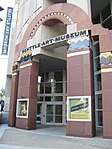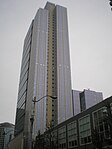Dendreon
Dendreon is a biotechnology company. Its lead product, Provenge (known generically as sipuleucel-T), is an immunotherapy for prostate cancer. It consists of a mixture of the patient's own blood cells (autologous, with dendritic cells thought to be the most important) that have been incubated with the Dendreon PAP-GM-CSF fusion protein. Phase III clinical trial results demonstrating a survival benefit for prostate cancer patients receiving the drug were presented at the AUA meeting on April 28, 2009. After going through the approval process, Provenge was given full approval by the FDA on April 29, 2010. Dendreon's stock value fell 66% on August 4, 2011, after abandoning its forecast for its debut drug Provenge.In November 2014, Dendreon filed for Chapter 11 bankruptcy protection and shortly afterwards announced that it had reached agreements on the terms of a financial restructuring with certain bond holders.On February 20, 2015, Valeant Pharmaceuticals received approval to purchase all Dendreon assets. On January 9, 2017 Sanpower Group agrees to acquire Dendreon from Valeant for $819.9 million In June 2017, Sanpower Group, a Chinese conglomerate, purchased Dendreon from Valeant for $820 million.
Excerpt from the Wikipedia article Dendreon (License: CC BY-SA 3.0, Authors).Dendreon
2nd Avenue, Seattle Belltown
Geographical coordinates (GPS) Address Nearby Places Show on map
Geographical coordinates (GPS)
| Latitude | Longitude |
|---|---|
| N 47.607948 ° | E -122.338547 ° |
Address
Russell Investments Center
2nd Avenue 1301
98101 Seattle, Belltown
Washington, United States
Open on Google Maps











